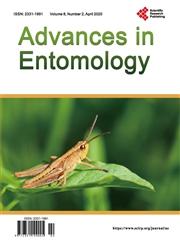Zoonotic Pathogens Detected in Ticks in Kenyan Game Reserves
引用次数: 0
Abstract
Little is known on tick-borne pathogens and their role in disease in game reserves in Kenya. Ticks were collected by sterile forceps from restrained cattle hide and placed into labeled falcon tubes. Ticks were screened for pathogens by High Resolution Melting (HRM) analysis and sequencing of specific RT-PCR products of Anaplasma, Ehrlichia, and Rickettsia species. A total of 317 ticks (281 adult ticks and 36 nymphs) comprising seven species were collected around the Tsavo National Reserve (TNR) in Taita Taveta County with Amblyomma gemma being the most commonly collected species (n = 135, 42.6%). From near Shimba Hill game reserve (SHNR), a total of 240 adult’s ticks were sampled, representing eight species, with again Amblyomma gemma being the most sampled species (n = 156, 65%). From Tsavo, a total of three pools of Rhipicephalus appendiculatus were positive for Theileria parva, two pools of Rhipicephaline evertsi for Anaplasma platys and one pool of Amblyomma variegatum nymphs for Rickettsia africae. Rickettsia africae, which causes African tick-bite fever, was detected in two pools of Am. variegatum and one pool of Amblyomma gemma collected near Shimba Hill game reserve. Rickettsia sp. and Anaplasma sp. were detected in Am. gemma and Rh. evertsi respectively. Rickettsia aeschlimannii was detected in a pool of Am. gemma. These findings highlight the risk of transmission of zoonotic pathogens to humans in regions with high human-wildlife interfaces. Of specific importance, we provide evidence of R. aeschlimannii in A. gemma for the first time, representing a potential new R. aeschlimannii vectors.在肯尼亚野生动物保护区的蜱虫中检测到人畜共患病原体
人们对肯尼亚野生动物保护区的蜱传病原体及其在疾病中的作用知之甚少。用无菌镊子从受限的牛皮上收集蜱虫,放入有标签的猎鹰管中。采用高分辨率熔融(HRM)分析和特异RT-PCR产物测序技术,对蜱蜱无形体、埃利希体和立克次体进行病原体筛选。在tita Taveta县Tsavo国家级自然保护区共采集蜱7种317只,其中成蜱281只,雌雄蜱36只,其中最常见的蜱种为双眼蜱(Amblyomma gemma),占42.6%。在新巴山野生动物保护区(SHNR)附近共采集到8种成蜱240只,其中以麻蜱(Amblyomma gemma)最多(n = 156,65 %)。察沃市共有3个尾尾鼻虫小芽孢杆菌阳性,2个尾尾鼻虫无原体阳性,1个异长弱视虫阳性,非洲立克次体阳性。引起非洲蜱叮咬热的非洲立克次体在美国的两个水池中被发现。在辛巴山野生动物保护区附近采集的一池斑鲷和一池斑鲷。在Am中检出立克次体和无形体。杰玛和Rh。evertsi分别。在Am池中检测到艾氏立克次体。吉玛。这些发现突出了在人类与野生动物高度接触的地区,人畜共患病原体向人类传播的风险。特别重要的是,我们首次提供了在金秋麻中发现埃氏黑僵菌的证据,这可能是一种新的埃氏黑僵菌传播媒介。
本文章由计算机程序翻译,如有差异,请以英文原文为准。
求助全文
约1分钟内获得全文
求助全文

 求助内容:
求助内容: 应助结果提醒方式:
应助结果提醒方式:


